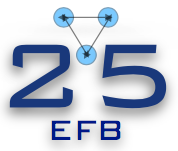Speaker
Description
The ongoing progress in derivation the chiral two- and many-nucleon forces in the framework of chiral perturbation theory (χPT) [1,2] gives better and better understanding of nuclear phenomena, but also brings many challenges for application of these forces beyond the two-nucleon (2N) system. While general operator form of three nucleon force (3NF) is currently known up to N4LO [3-6], its practical implementation to the bound systems and to the scattering problems is delayed. The main obstacles are necessity of consistent, with what is used in 2N force, regularization of the 3NF, performing partial wave decomposition of 3NF, and last but not least fixing it’s free parameters. It is expected that at N4LO there are thirteen free parameters to be fixed from 3N data. Due to the computational complexity of 3N calculations it is unpractical to apply standard fitting methods in that case.
In this contribution, we focus on the latter problem and propose fast and efficient way to obtain approximated solution of 3N scattering problem [7-9] within the Faddeev approach. We apply that new emulator to investigate the importance of the 3NF N2LO and N4LO contact terms in elastic nucleon-deuteron (Nd) scattering. Specifically, we use the N4LO+ chiral semilocal momentum space regularized 2N chiral potential [10] supplemented by N2LO 3NF [11] and all subleading N4LO 3NF contact terms [5-6]. Inclusion of the N4LO 3NF contact terms yields an improved description of the elastic Nd scattering observables in a wide range of incoming nucleon energies up to 250 MeV. We will discuss both the new equations forming the emulator, the procedure for establishing the LEC values, the quality of the approximation made, and finally the results based on them showing the influence of the N4LO terms on the Nd cross sections and selected polarisation observables.
[1] E.Epelbaum, H-W.Hammer, and U-G.Meiβner, Rev Mod Phys 81 (2009) 1773.
[2] R.Machleidt and D.R.Entem, Phys. Rep. 503, 1 (2011).
[3] H.Krebs, A.Gasparyan, and E.Epelbaum, Phys. Rev. C 85, 054006 (2012).
[4] H.Krebs, A.Gasparyan, and E.Epelbaum, Phys. Rev. C 87, 054007 (2013).
[5] L.Girlanda, A.Kievsky, and M.Viviani, Phys. Rev. C 84, 014001 (2011).
[6] L.Girlanda, A.Kievsky, and M.Viviani, Phys. Rev. C 102, 019903(E) (2020).
[7] H.Witała, J.Golak, R.Skibiński, and K.Topolnicki, Few-Body Syst. 62, 23 (2021).
[8] H.Witała, J. Golak, and R. Skibiński, Eur. Phys. J. A 57, 241 (2021).
[9] H.Witała, J. Golak, and R. Skibiński, Phys. Rev. C105, 054004 (2022).
[10] P.Reinert, H.Krebs, and E.Epelbaum, Eur. Phys. J. A 54, 86 (2018).
[11] E.Epelbaum et al., Phys. Rev. C 66, 064001 (2002).

